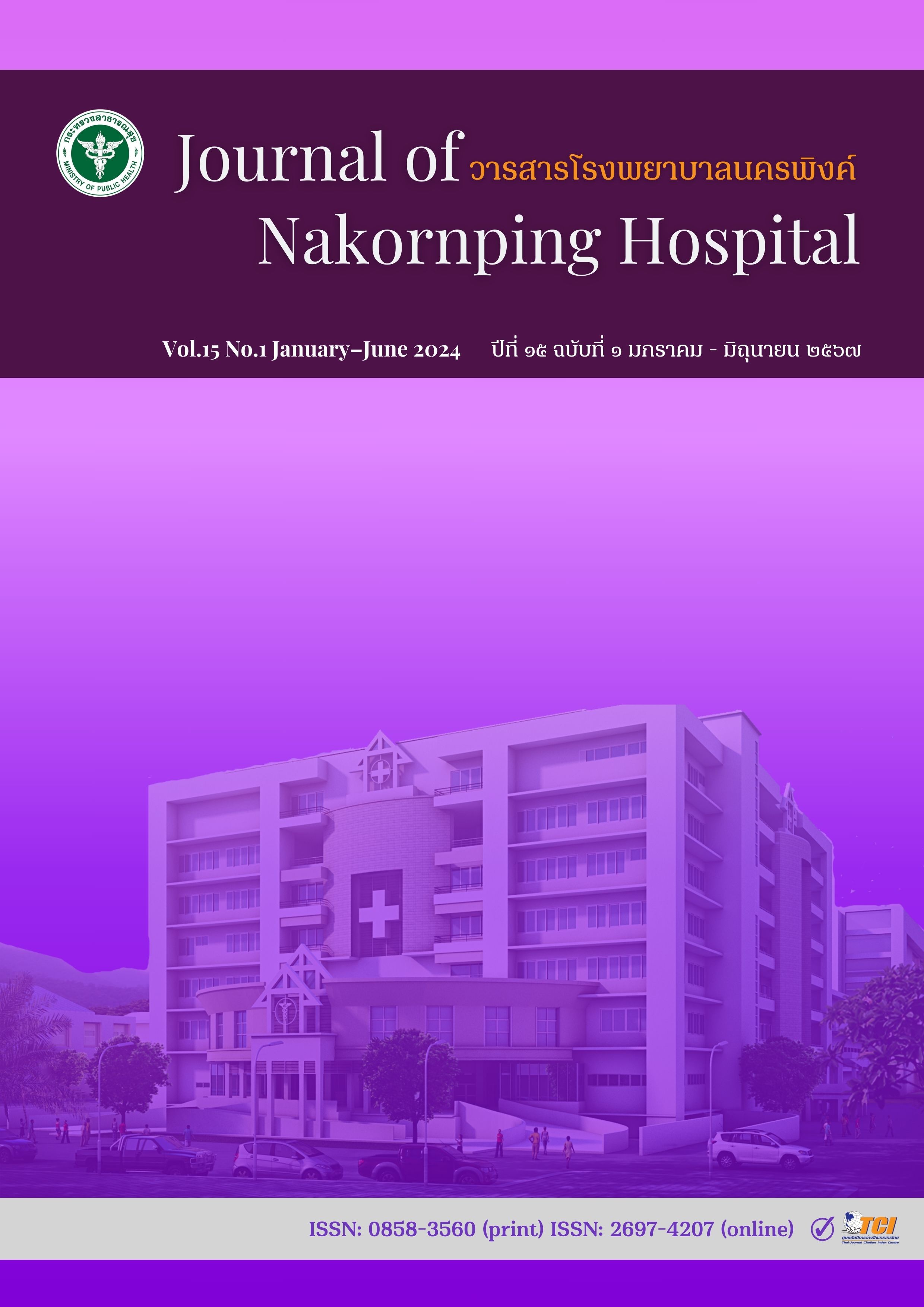The effects of using multi-system trauma care nursing practices in Accident and Emergency Department, Lamphun Hospital
Keywords:
multi- systems trauma, nursing practices, accident and emergency departmentsAbstract
Objectives: To compare knowledge and satisfaction of nurses before and after implementing multi-system trauma care nursing practices and outcomes of multi-system trauma patients at the Accident and Emergency department, Lamphun Hospital.
Methodology: It was quasi-experimental research conducted during January to June 2023. The sample group comprised 25 nurses and 43 patients before using the guideline, and 20 patients after using the guideline for multi-system trauma care nursing practices at the Accident and Emergency department of Lamphun Hospital. The research tools included multi-system trauma care nursing practices, knowledge assessment form, nursing practice assessment form, nurse satisfaction assessment form, and patient record forms. Data were analyzed using T-tests and Fisher’s exact test.
Results: A total of 25 nurses participated. Most of them were female (84.0%) and aged between 31 and 40 years (44.0%). All had a bachelor's degree, 48.0% had working experience in accident and emergency work less than 5 years, and 76.0% had never received specialized training for accident and emergency patients. Evaluation before and after using the guidelines for nursing knowledge scores in caring for multi-system trauma patients averaged 13.70 ± 2.28 and 18.20 ± 2.00, respectively (p < 0.001). Correct scores in nursing practice in caring for multi-system trauma patients increased from 72.0% to 92.0% (p < 0.001). Nurses expressed a high level of satisfaction with the use of the guidelines (mean ± SD = 4.04 ± 0.41). Regarding patient care results, it was found that the average time of patients being evaluated and prepared for surgery within 60 minutes before using the guidelines was 68.13 ± 40.85 minutes, which was reduced to an average of 48.10 ± 16.60 minutes after using the guidelines (p < 0.039). The mortality rate for multi-system injury patients before implementing the guidelines was 16.3%, and after implementing the guidelines, it decreased to 5.0% (p < 0.042).
Conclusion: The study has shown that this practice guideline helps to develop knowledge and nursing practice in caring for patients with multi-system injuries, resulting in increased satisfaction among nurses, reduced time to prepare for operations, and ultimately a decrease in mortality. Active implementing the guideline should be warranted the patients outcome.
References
van Breugel JMM, Niemeyer MJS, Houwert RM, Groenwold RHH, Leenen LPH, van Wessem KJP. Global changes in mortality rates in polytrauma patients admitted to the ICU-a systematic review. World J Emerg Surg. 2020;15(1):55. doi: 10.1186/s13017-020-00330-3.
Jakobsen RK, Bonde A, Sillesen M. Assessment of post-trauma complications in eight million trauma cases over a decade in the USA. Trauma Surg Acute Care Open. 2021;6(1):e000667. doi: 10.1136/tsaco-2020-000667.
Böhmer AB, Just KS, Lefering R, Paffrath T, Bouillon B, Joppich R, et al. Factors influencing lengths of stay in the intensive care unit for surviving trauma patients: a retrospective analysis of 30,157 cases. Crit Care. 2014;18(4):R143. doi: 10.1186/cc13976.
World Health Organization. Death on the roads Base on the WHO Global Status Report on Road Safety 2018 [Internet]. Genneva: World Health Organization; 2018. [cited 2022 Dec 28]. Available from: https://extranet.who.int/roadsafety/death-on-the-roads/#ticker
Curry N, Hopewell S, Dorée C, Hyde C, Brohi K, Stanworth S. The acute management of trauma hemorrhage: a systematic review of randomized controlled trials. Crit Care. 2011;15(2):R92. doi: 10.1186/cc10096.
Yoosook S, Suwanmontri P, Charoenrat P, Nilsonthi N. Developing a Model of Care for the Multiple Trauma Hypovolemic Shock Patients in Sawanpracharak Hospital. Department of Health Service Support Journal. 2017;13(2):39-49. [In Thai]
Kanchanitanont C, Vipavakarn S, Prombutr R. The Development of Nursing Care Model for Severe Multiple Injury in Krabi Hospital. Journal of the Royal Thai Army Nurses. 2019;20(1):339-50. [In Thai]
Lamphun Hospital, Accident and Emergency Department. Fast-track nursing situation for multi-system trauma patients with critical conditions. Lamphun: Accident and Emergency Department Lamphun Hospital; 2023. [In Thai]
Picheansathian W. Searching the Evidence: Essential Skill for Nurse in Thailand 4.0. Thai Journal of Nursing and Midwifery Practice. 2018;5(1):136-48. [In Thai]
Kanhadilok S, Punsumreung T, Malai C. Evidence Based Teaching Strategies in Nursing. Journal of Nursing and Health Care. 2017;35(4):34-41. [In Thai]
Collicott PE. Advanced Trauma Life Support (ATLS): past, present, future--16th Stone Lecture, American Trauma Society. J Trauma. 1992;33(5):749-53.
Phanwan S, Borvornsudhasin P. The Development of a Fast Track of Care forMultiple Injury in Suratthani Hospital. Region 11 Medical Journal. 2021;36(1):32-49. [In Thai]
Krejcie RV, Morgan DW. Determining Sample Size for Research Activities. Educational and Psychological Measurement. 1970;30(3):607-10. doi: https://doi.org/10.1177/001316447003000308
Teeradechakul N, Promchai N, Ponsane N. Effective of Nursing Development the Multiple in jury patient with Multiple In jury Nursing Management Guideline. Medical Journal of Srisaket Surin Buriram Hospitals. 2018;33(2):165-77. [In Thai]
Rotchanahiran M. Effectiveness of Clinical Nursing Practice Guideline for the trauma patient with multiple injury In Emergency Department, Udon Thani Hospital. Udonthani Hospital Medical Journal. 2020;28(3):413-25. [In Thai]
Downloads
Published
How to Cite
Issue
Section
License
Copyright (c) 2024 Nakornping Hospital

This work is licensed under a Creative Commons Attribution-NonCommercial-NoDerivatives 4.0 International License.
The articles that had been published in the journal is copyright of Journal of Nakornping hospital, Chiang Mai.
Contents and comments in the articles in Journal of Nakornping hospital are at owner’s responsibilities that editor team may not totally agree with.



